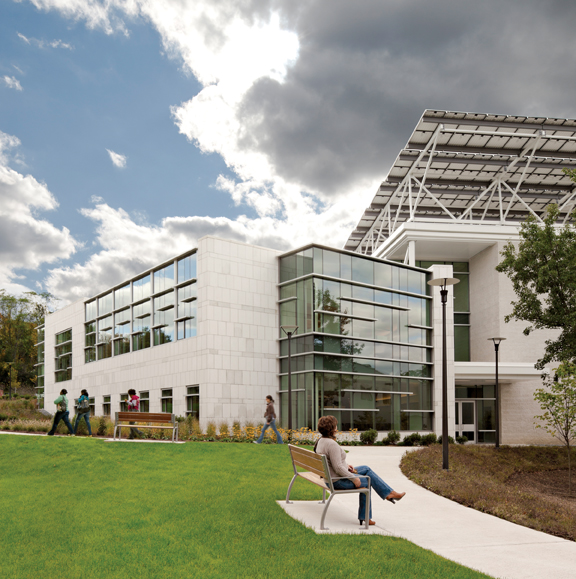The green building movement is poised on the brink of a new, more mature stage of development. Net-zero energy, net-zero water, net-zero waste, even net-zero stormwater projects—once thought to be impossible to achieve—are popping up all over. The Living Building Challenge, deemed by many practitioners to be the most arduous certification standard to meet, is winning the hearts and minds of AEC supergreenies seeking a competitive edge for their firms. And the fourth iteration of LEED, while having missed its anticipated unveiling at Greenbuild this month, should be out sometime in mid-2013.
“Green building is not a curiosity anymore,” says Aditya Ranade, Senior Analyst with Lux Research, which predicts the sector will reach $280 billion globally by 2020.
The big buzz: disclosure and transparency, says Russell Perry, FAIA, LEED Fellow, Senior Vice President with design firm SmithGroupJJR. He points to the recent release of publicly disclosed building energy use in New York City as an example of “increased visibility” that will contribute to the knowledge base on building performance.
Building product manufacturers are responding to the call for disclosure and transparency by issuing environmental product declarations to differentiate their products from the competition’s. Perry says EPDs will play a greater role in Materials & Resources credits for LEED v4.
Most recently, the International Living Future Institute launched Declare, a database of green building products (http://www.declareproducts.com) that provides a kind of “nutrition label” of product ingredients—all in support of the Living Building Challenge’s “Red List” and “Appropriate Sourcing” imperatives.
Also in the works: the Health Product Declaration Open Standard, a new “product chemistry disclosure tool” that its developers—the Healthy Building Network and BuildingGreen—say will provide manufacturers with a consistent format for reporting product content and associated health information. The HPD, which went through a pilot phase with more than 30 building product makers earlier this year, will be launched at Greenbuild.
Finally, there’s the Honest Buildings Network (www.honestbuildings.com), an open-network database that seeks to connect stakeholders in the real estate industry to “drive demand for better buildings all over the world.” Founder Riggs Kobiak calls it “a cross between Yelp and LinkedIn for the built environment.”
In the following pages, the editors present numerous highly sustainable projects, along with trends and ideas from leading AEC green building firms. +
Related Stories
| Aug 11, 2010
Citizenship building in Texas targets LEED Silver
The Department of Homeland Security's new U.S. Citizenship and Immigration Services facility in Irving, Texas, was designed by 4240 Architecture and developed by JDL Castle Corporation. The focal point of the two-story, 56,000-sf building is the double-height, glass-walled Ceremony Room where new citizens take the oath.
| Aug 11, 2010
Carpenters' union helping build its own headquarters
The New England Regional Council of Carpenters headquarters in Dorchester, Mass., is taking shape within a 1940s industrial building. The Building Team of ADD Inc., RDK Engineers, Suffolk Construction, and the carpenters' Joint Apprenticeship Training Committee, is giving the old facility a modern makeover by converting the existing two-story structure into a three-story, 75,000-sf, LEED-certif...
| Aug 11, 2010
Utah research facility reflects Native American architecture
A $130 million research facility is being built at University of Utah's Salt Lake City campus. The James L. Sorenson Molecular Biotechnology Building—a USTAR Innovation Center—is being designed by the Atlanta office of Lord Aeck & Sargent, in association with Salt-Lake City-based Architectural Nexus.
| Aug 11, 2010
San Bernardino health center doubles in size
Temecula, Calif.-based EDGE was awarded the contract for California State University San Bernardino's health center renovation and expansion. The two-phase, $4 million project was designed by RSK Associates, San Francisco, and includes an 11,000-sf, tilt-up concrete expansion—which doubles the size of the facility—and site and infrastructure work.
| Aug 11, 2010
Goettsch Partners wins design competition for Soochow Securities HQ in China
Chicago-based Goettsch Partners has been selected to design the Soochow Securities Headquarters, the new office and stock exchange building for Soochow Securities Co. Ltd. The 21-story, 441,300-sf project includes 344,400 sf of office space, an 86,100-sf stock exchange, classrooms, and underground parking.
| Aug 11, 2010
New hospital expands Idaho healthcare options
Ascension Group Architects, Arlington, Texas, is designing a $150 million replacement hospital for Portneuf Medical Center in Pocatello, Idaho. An existing facility will be renovated as part of the project. The new six-story, 320-000-sf complex will house 187 beds, along with an intensive care unit, a cardiovascular care unit, pediatrics, psychiatry, surgical suites, rehabilitation clinic, and ...
| Aug 11, 2010
Colonnade fixes setback problem in Brooklyn condo project
The New York firm Scarano Architects was brought in by the developers of Olive Park condominiums in the Williamsburg section of Brooklyn to bring the facility up to code after frame out was completed. The architects designed colonnades along the building's perimeter to create the 15-foot setback required by the New York City Planning Commission.
| Aug 11, 2010
Wisconsin becomes the first state to require BIM on public projects
As of July 1, the Wisconsin Division of State Facilities will require all state projects with a total budget of $5 million or more and all new construction with a budget of $2.5 million or more to have their designs begin with a Building Information Model. The new guidelines and standards require A/E services in a design-bid-build project delivery format to use BIM and 3D software from initial ...
| Aug 11, 2010
Opening night close for Kent State performing arts center
The curtain opens on the Tuscarawas Performing Arts Center at Kent State University in early 2010, giving the New Philadelphia, Ohio, school a 1,100-seat multipurpose theater. The team of Legat & Kingscott of Columbus, Ohio, and Schorr Architects of Dublin, Ohio, designed the 50,000-sf facility with a curving metal and glass façade to create a sense of movement and activity.







